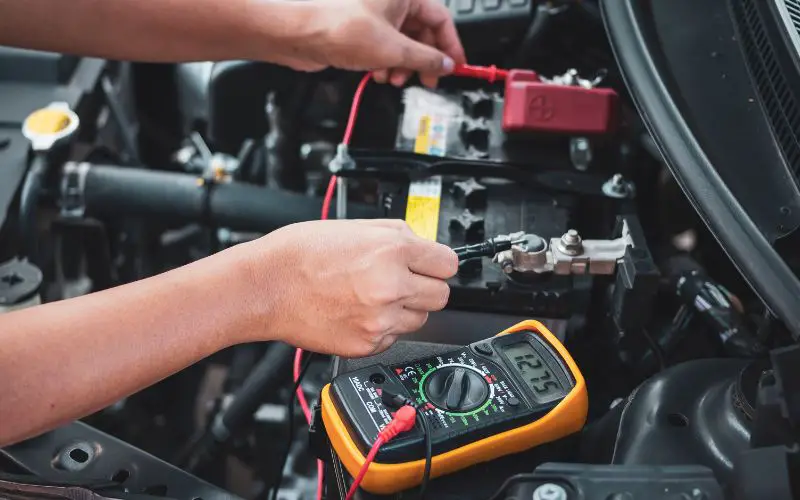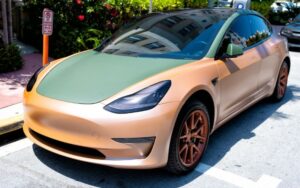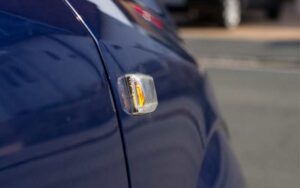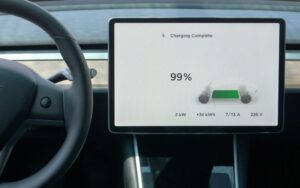How Long Does a Tesla Battery Last? Lifespan Revealed!
Last updated on September 21st, 2023 at 09:37 am
So you are considering getting a Tesla but wondering how long the batteries will last?
Well, it’s a great thing any potential electric vehicle owner must consider before dropping huge amounts of money on an electric vehicle.
Tesla batteries last much longer than some critics claim, but how long do they last?
The lifespan of Tesla’s battery is about 300,000-500,000 miles. The lifespan depends on factors like the model and how you use the vehicle. It would help to know that the battery of a Tesla starts to lose capacity after eight years; regardless, you can expect several years of solid performance before the range starts to drop significantly.
I will explain everything you need about your Tesla battery in this article. By the end, you will know all about the lifespan of the battery of your Tesla and what you can do to maximize it.
What Is the Life Expectancy of a Tesla Battery?

The battery is the heart of a Tesla, so it would help to consider how long it lasts before buying one. The good news is Tesla developed their batteries to last.
Typically, the life expectancy of a Tesla’s battery is around 300,000 to 500,000 miles. The battery, however, may start to lose some capacity over time.
The drop in range depends on your Tesla model and the usage level.
For instance, after eight years, the battery in an older Model S can drop to around 70% of the original maximum range.
Generally, several other factors determine how long a Tesla’s battery will last.
To begin with, the more you charge your vehicle’s battery, the more it wears down over time.
In addition, extreme heat or cold can accelerate battery degradation. Parking in a garage and limiting DC fast charging helps.
Tesla has designed most models to retain about 70% capacity after eight years of usage.
Generally, while the battery life will decrease over time, Tesla’s battery management system actively monitors each cell to ensure your range remains as consistent as possible.
With proper care and maintenance, you can expect to get at least 10 to 15 years out of your vehicle’s battery before a major drop In range.
What Type of Battery Does Tesla Use?
Tesla utilizes lithium-ion batteries in all of their cars. The high-capacity batteries comprise thousands of small cells that work together to power your electric vehicle.
Lithium-ion batteries have come a long way; although Tesla designs them to last long, you understand they won’t last forever.
Tesla aims for their batteries to retain at least 70% of their capacity after eight years of typical use.
That implies that even after racking up all those miles, your battery will still have plenty of range.
For instance, a Tesla with a 300-mile range when new should still go at least 210 miles on a full charge after eight years.
Of course, it’s normal to expect some battery degradation over time.
Generally, the rate at which a lithium-ion battery degrades depends on the temperature, charge levels, and individual usage.
However, storing and charging your Tesla according to the recommendations in the owner’s manual will help maximize your battery’s lifespan.
When the time comes to replace your Tesla battery, the cost will depend on the capacity.
However, with proper care and maintenance, the advanced lithium-ion batteries in Tesla vehicles will provide many years of all-electric driving with minimal loss of capacity.
How Much Does a Tesla Battery Replacement Cost?
A Tesla battery replacement is not inexpensive. However, it ultimately depends on your Tesla model, labor, and the needed parts.
Replacing a Tesla battery will cost you about $5000 to $20000.
A new 75kWh Model S battery costs between $13,000 to $15,000, depending on your vehicle’s year and trim level. Also, newer 100kWh batteries are $16,000 to $20,000.
It would help to know that Tesla’s battery warranty covers eight years or about 150,000 miles, depending on the model.
Therefore if your Tesla’s range drops below 70% of the original rated range during that period, Tesla will repair or replace the battery.
The good news is that Tesla’s lithium-ion batteries are durable, so degradation is usually gradual.
When replacing your Tesla battery, you have two options: get a brand-new replacement battery from Tesla or use a refurbished one.
A more budget-friendly choice is a refurbished battery from Tesla or a third party.
Refurbished batteries are tested and brought up to working condition, offering a lower upfront cost.
However, it would help to know that they usually have a shorter warranty. Prices for refurbished 75 kWh Tesla batteries range from $8000 to $12000.
Ultimately, the best option is your budget and how long you plan to keep your Tesla.
Regardless, replacing your Tesla’s battery will allow you to continue enjoying your vehicle for years after the depletion of the original battery.
Five Tips to Make Tesla Batteries Last Longer
Several factors affect Tesla’s battery life; the biggest two are charging and temperature. How and where you charge your vehicle can either help or hurt your battery’s lifespan.
The good news is that you can employ a few tricks to elongate your battery’s lifespan.
Here are five tips to get the most out of your Tesla battery.
#1. Regular Charging
The battery of your vehicle lasts longer when used regularly.
Try to charge your Tesla at least once a week to keep the electrons flowing. Letting it sit idle without charging can reduce the battery’s capacity over time.
#2. Avoid Extreme Temperatures
High temperatures accelerate battery degradation. As such, park your Tesla in a garage or shaded area when possible. The cooler the temperature, the better.
#3. Software Updates
Ensure to install all software updates from Tesla to ensure your car and battery have the latest optimizations and safety features.
Generally, updates often improve battery management and charging functions and consequently help maximize the range and lifespan of the battery.
#4. Don’t Leave Your Battery Plugged In
While leaving your Tesla plugged in when not in use is fine, don’t charge at 100% for extended periods, as it can reduce the battery’s lifespan.
Unplug it once it reaches the target charge level for daily use. You can charge 80-90% for daily use and 100% for long trips.
#5. Limit Supercharging
Only use superchargers when necessary for long trips.
While convenient, fast charging can generate more heat and reduce battery life over time. For daily use, standard level 2 charging is best.
By following the above tips, you can keep your Tesla battery in top shape for years to come and avoid any nasty surprises with the battery life of your electric vehicle.
How Long Does a Tesla Battery Last After a Full Charge?
Maybe you are wondering how long your Tesla battery will last after a full charge; well, the answer depends on several factors, including:
- The model of Tesla you own.
- The way you drive.
- The ambient temperature.
- The various accessories are in use when driving.
On average, your Tesla battery will last about 260 to 370 miles after a full charge.
Generally, the Model 3 will last about 267 miles after a full charge, while the Model S, with a longer range, will last for about 405 miles.
It is important to note that aggressive driving at high speeds drains the battery faster. As such, you should always drive at a lower speed to maximize your range per charge.
In addition, extreme temperatures affect the range of your Tesla, so it’s normal to experience shorter ranges during extreme cold or hot temperatures.
The battery of your Tesla performs better at moderate temperatures.
Furthermore, using features like the heater, air conditioner, or entertainment system draws extra power from the battery and decreases your range.
With normal driving conditions and proper care, you can use a fully charged Tesla for days, depending on the above factors.
What Are Some Key Factors that Contribute to the Lifespan of a Tesla Battery?
When it comes to the lifespan of a Tesla battery, there are several key factors to consider. First and foremost, regular maintenance and charging practices play a crucial role. Additionally, the number of charge cycles a battery undergoes, extreme temperatures, and fast-charging habits can impact its longevity. By adopting proper care and understanding these tesla battery facts revealed, owners can optimize their battery’s lifespan and overall performance.
Which Tesla Model Has the Best Battery Life?
While Tesla has several models, the Tesla Model S has the best battery life of any Tesla vehicle.
Depending on the model year and options, the Model S can achieve an EPA-estimated range of up to 405 miles on a single charge.
It would help to know that if the maximum driving range is important to you, you should opt for the long-range versions.
Several factors contribute to the impressive battery performance of the Model S.
To begin with, it’s a 100 kWh lithium-ion battery pack, one of the largest in any all-electric vehicle. More battery cells mean more energy storage and a longer range.
In addition, an efficient all-wheel-drive system reduces energy loss. The dual motor setup provides instant torque to all four wheels for smooth acceleration while maximizing range.
Also, advanced battery temperature control using a liquid cooling and heating system.
Maintaining an optimal battery temperature is key to maximizing capacity and longevity.
Furthermore, the Model S has software and systems optimized for energy efficiency.
Everything from regenerative braking to climate control is designed to minimize power draw from the battery.
Overall, the Model S stands out as a pioneer of long-range, high-performance electric mobility and doesn’t come cheap, either.
Let’s look at other models and battery ranges in the table below.
| Tesla Model | Range of Model |
|---|---|
| Tesla Model 3 Long Range | About 334 miles |
| Tesla Model 3 Standard Range | About 267 miles |
| Tesla Model X | About 332 miles |
| Tesla Model Y Performance | About 303 miles |

Hey, I’m Michael Davis, a 35-year-old with a degree and a love for cars and tech. Since I was a kid, cars have been my thing—so much that I even thought they ran on magic beans! Fast forward, and I’ve built Vehicle Army, your one-stop-shop for easy-to-understand car facts.






